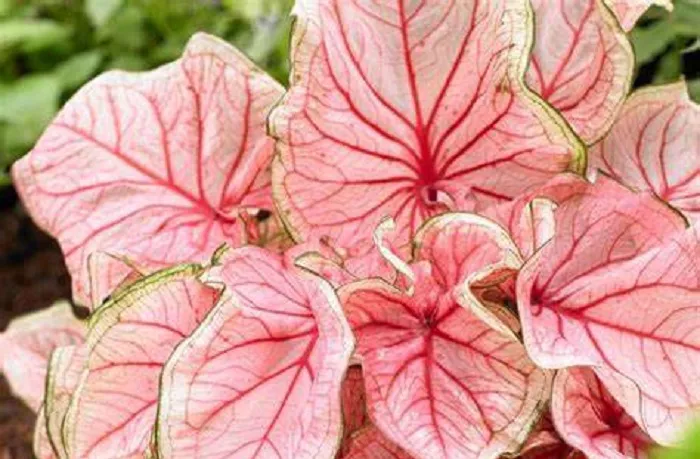Caladiums, with their vibrant and heart-shaped leaves, are a stunning addition to any garden. While primarily grown for their foliage, understanding how to pollinate caladium flowers can enhance your gardening skills and potentially lead to the production of seeds for future plantings. This article delves into the intricacies of caladium pollination, offering practical tips and insights to ensure successful fertilization.
Understanding Caladium Flowers
Caladiums are tuberous plants native to South America, known for their ornamental leaves rather than their flowers. However, their small, inconspicuous flowers do play a crucial role in reproduction. These flowers are typically found on a spadix, surrounded by a spathe, which is often mistaken for the flower itself. The flowers are bisexual, meaning they contain both male and female parts, but they often require cross-pollination to produce viable seeds.
The Role of Pollinators
In their natural habitat, caladiums rely on specific pollinators such as beetles and flies. These insects are attracted to the spathe’s scent and color, which mimic decaying organic matter. In a garden setting, however, these pollinators might not be readily available, making manual pollination a valuable technique for gardeners.
Preparing for Pollination
Before diving into the pollination process, it’s essential to ensure your caladium plants are healthy and in the right environment. Caladiums thrive in warm, humid conditions with well-drained soil and partial shade. Proper care will increase the likelihood of successful pollination.
Identifying the Right Time
Timing is crucial when it comes to pollinating caladium flowers. The flowers are typically ready for pollination when the spadix is fully extended and the spathe is open. This usually occurs during the plant’s active growing season, which is from spring to early fall.
Tools and Materials
Manual pollination requires a few simple tools. A small, soft brush or cotton swab is ideal for transferring pollen. You may also need a magnifying glass to better see the flower parts, especially if you are working with smaller varieties.
The Pollination Process
Pollinating caladium flowers involves a few careful steps to ensure the pollen reaches the female parts of the flower. Here’s a detailed guide to help you through the process:
Inspecting the Flowers
Begin by closely examining the spadix. The male flowers are usually located at the upper part of the spadix, while the female flowers are found at the lower part. Look for signs of pollen production, which indicates that the male flowers are mature and ready for pollination.
Collecting Pollen
Using your brush or cotton swab, gently collect pollen from the male flowers. Be careful not to damage the flowers in the process. The pollen should adhere to the brush or swab, making it easy to transfer.
Transferring Pollen
Once you have collected the pollen, carefully move the brush or swab to the female flowers. Gently brush the pollen onto the stigma, which is the receptive part of the female flower. Ensure that the pollen is evenly distributed to maximize the chances of successful fertilization.
Repeating the Process
To increase the likelihood of successful pollination, it’s a good idea to repeat the process over several days. This ensures that you capture pollen from multiple male flowers and transfer it to several female flowers, increasing the chances of fertilization.
Post-Pollination Care
After pollination, it’s important to provide the right care to support seed development. Continue to maintain optimal growing conditions, including consistent watering and adequate humidity. Avoid overwatering, as this can lead to tuber rot and negatively impact seed production.
Monitoring for Seed Development
Keep an eye on the flowers after pollination. If fertilization is successful, the flowers will begin to develop into seed pods. These pods will gradually grow and eventually split open, revealing the seeds inside. It’s important to protect the developing seed pods from pests and adverse weather conditions.
Harvesting Seeds
Once the seed pods have fully matured and split open, carefully harvest the seeds. They can be stored in a cool, dry place until you are ready to plant them. Properly stored caladium seeds can remain viable for several years, allowing you to grow new plants and continue the cycle.
Challenges and Tips
Pollinating caladium flowers can come with its own set of challenges. One common issue is the lack of pollinators in a garden setting. Manual pollination, as described, is a reliable way to overcome this. Additionally, environmental factors such as temperature and humidity can impact the success of pollination. Ensuring that your caladiums are in the right conditions will increase your chances of success.
Enhancing Pollinator Attraction
If you prefer to rely on natural pollinators, there are ways to attract them to your garden. Planting companion plants that attract beetles and flies can help draw these pollinators to your caladiums. Additionally, providing a moist, organic-rich environment can mimic the natural habitat of these insects, making your garden more appealing.
Patience and Persistence
Pollinating caladium flowers requires patience and persistence. Not all attempts will result in successful seed production, but with practice and attention to detail, you can achieve rewarding results. Each attempt provides valuable insights and helps you refine your technique for future pollinations.
Conclusion
Pollinating caladium flowers is a fascinating and rewarding process for any gardener. By understanding the flower structure, timing, and techniques involved, you can successfully fertilize your caladiums and potentially produce seeds for future plantings. Whether you choose to rely on natural pollinators or take matters into your own hands with manual pollination, the journey is both educational and fulfilling. With proper care and attention, your caladiums can thrive and continue to bring beauty to your garden for years to come.


